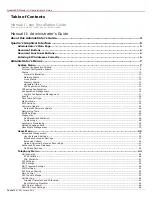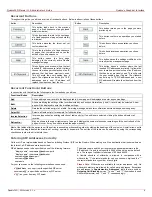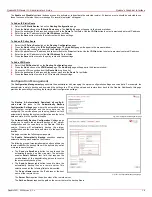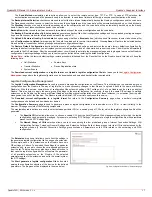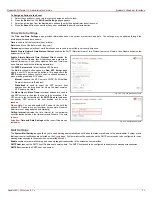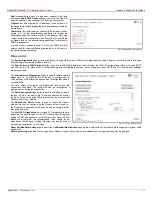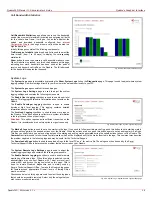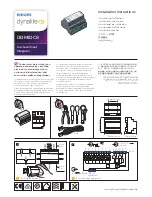
QuadroFXO Manual II: Administrator's Guide
Quadro's Graphical Interface
QuadroFXO; SW Version 5.1.x
14
Hardware Status
The Hardware Status table displays a list of the hardware devices
present and currently available on the Quadro board. The hardware
device version number and additional comments about its state are
indicated here.
Fig. II-18: Hardware Status page
SIP Registration Status
The SIP Registration Status is a table displaying the SIP registration
information of the Quadro extensions.
The table contains a list of all the registered extensions of Quadro, SIP
registration name for each extension, addresses of SIP servers where
they are registered (if applicable), whether or not it is registered for each
extension, and the registration date and time. By clicking on the row
heading, the table will be sorted by the selected column. When sorting
(ascending or descending), arrows will be displayed next to the column
heading.
The links inside the table will link you to the
–
Edit Entry page where the SIP registration settings may be altered.
The Detected Connection Type field displays the connection type
Quadro currently is acting in (direct connection or behind NAT). If
Quadro is acting behind NAT, the NAT machine IP address is also
displayed.
The SIP Tunnels to Slave Devices and SIP Tunnels to Master
Devices tables list the SIP tunnels between local and the remote
Quadros (see
). The SIP Tunnels to Slave
Devices table lists those tunnels where local Quadro acts as a master.
The SIP Tunnels to Master Devices table lists those tunnels where
local Quadro acts as a slave.
Fig. II-19: SIP Registration Status page
IP Routing Configuration
Routing is used to relay information across the Internet from a source to a destination. Along the way, at least one intermediate node is typically
encountered. Routing is different than bridging. The main difference between bridging and routing is that bridging operates at the OSI Data Link
Layer (Level Two Media Access Control Layer) and routing operates at OSI Network Layer (Level Three).
Quadro’s IP Routing service allows you to route IP packets from one destination to another (or to a specified router) through Quadro.
The IP Routing Configuration page is used to make IP Static and IP Policy routes for IP packets routing. This page consists of two tables. Entries
in the tables are color coded according to the state of the route. For example, yellow indicates disabled routes, green indicates successful routes and
red indicates routes with an error.
IP Static Routes are used to forward IP packets from the
Network, where the Quadro is connected, to the specified
destination.
The IP Static Routes table displays all established IP static
routes with their parameters: Target State for the state of the
route (enabled or disabled), Actual State for the state of the route
connection (up, down or erroneous), Route To for the subnet
where the incoming packets should be routed to and Via IP
Address for the router IP address where incoming packets should
be routed through.
Add opens the Add IP Static Route page where a new static
route can be established.
Enable/Disable is used to activate and deactivate a selected
route(s). At least one route should be selected in order to use
these functions, otherwise the following error message will
appear: “No record(s) selected.”
Fig. II-20: IP Static Routing table


